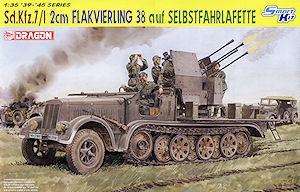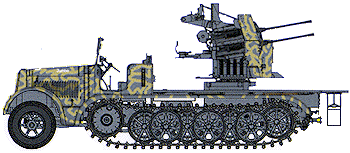The 2cm Flakvierling 38 auf Selbstfahrlafette Sd.Kfz.7/1 resulted from combining the 2cm Flakvierling 38 with four Flak38 guns to the Sd.Kfz.7 half-track to allow greater mobility and firepower with the Sd.Kfz.7/1 carrying 600 2cm rounds on board and a further 1800 rounds in the towed Sd.Ah.56 trailer.
The initial Sd.Kfz.7/1 had the Flakvierling 38 mounted on a central pivot mounting with later vehicles using the standard Flakvierling ground mounting secured by rachets on the rear bed. The later versions also included an armoured cab to better protect the crews.
Dragon first announced their kit of the Sd.Kfz.7 8t Half Track some time ago in response to the Trumpeter German Sd.Kfz.7 Mittlere Zugkraftwagen 8t early version (kit #01514) but this kit has yet to see the light of day.
Instead we have this new kit of the 2cm Flakvierling 38 auf Selbstfahrlafette which also coincides with the Trumpeter German 2cm Flakvierling 38 auf Selbstfahrlafette (Sd.Kfz.7/1 early version) with Sd.Anhanger 51 (kit #01523) (A full comparison to follow shortly)
The kit represents the earliest configuration of the Sd.Kfz.7/1 with the central circular pivot mounting for the 2cm Flakvierling 38 while later vehicles used the normal ground mounting fitted to the rear bed which allowed the gun to be easily removed and mounted on the standard Flakvierling Sd.Ah.52 trailer if required.
Included on the sprues are a few parts for the prime mover so this kit can’t be that far away with probably other versions to follow which will please half-track fans.
As mentioned the kit is brand new apart from the small weapons sprue for the 2 Kar98 rifles and consists of 374 parts in the usual light grey plastic plus an additional 108 individual “Magic Track” links, 6 clear plastic parts, 13 etched parts and 3 DS vinyl tyres along with the decal and instruction sheets.

Etched parts
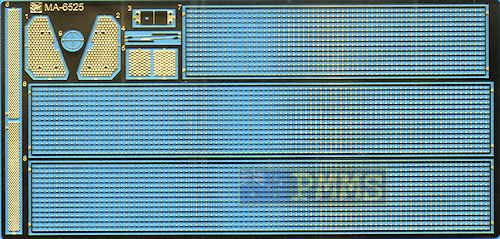
Clear parts

The standard of moulding is extremely good with clean crisp parts that did not have any flash apparent with just a few pin marks and the usual small moulding lines and many small plastic knock out nodes on the parts which requires a bit of care to remove on some of the smaller parts but the additional cleanup here results in overall cleaner parts free of blemishes. There was one small issue with my kit in that the large single chassis moulding was slightly warped at the back and care will be needed during assembly to straighten this while attaching the rear bed.
Dimensionally the kit matches available 1:35 plans and data nicely with any discrepancies well within acceptable tolerances
The kit gives you a full Maybach HL62TUK 6 cylinder engine and gearbox as well as the full chassis with rear mounted winch as well as the new 2cm Flakvierling 38 gun mounting which has 4 newly tooled 2cm Flak 38 guns and not those from the previous Dragon 2cm Flak 38 kits.
It also has for the first time the Dragon DS Vinyl used for the front and spare tyres as well as individual working “Magic Track” for the Zgw.50/360/180 tracks fitted to the early model Sd.Kfz.7 8t Half Tracks.
While the kit is very well done overall it is not without some issues as are most kits and I will simply present the facts here as always and it’s up to the individual to take or leave these as they see fit.
The main chassis frame is one large moulding that includes five cross members and is quite an impressive moulding with just some mould seams on the insides to be cleaned up, but as these are difficult to see after assembly you could even not bother.
The detail on all sides is crisply done but there was a minor issue with the chassis in my kit in that it was slightly warped at the rear end, this was nothing dramatic but will need care while fitting the additional parts to try and straighten out the chassis to ensure everything sits square after assembly.
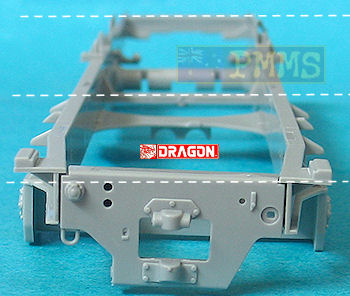
Added to the chassis are the rear suspension components and leaf springs and apart from cleaning up the fine mould seams everything fitted perfectly without the need for any trimming. At the front is the single suspension leaf spring with the correct contours and is moulded solid and not designed to articulate. Added to this is the large suspension stabiliser with front axle and a very fine steering arm that needs care removing from the sprues and cleaning up the fine mould seam. The front wheels are not deigned to be movable and are fixed in the neutral position but you could modify the position of the axle stubs with a little work if you wanted to show the wheels turning.
The inner chassis frame (part B57) is another impressive moulding with cleanly rendered details and you have to fit the two part muffler and exhaust pipes inside the frame. This requires you to feed the pipe and half the muffler into the frame “before” gluing the muffler halves together, don’t glue the muffler before hand or you will never get this inside the frame. This means you can’t clean up the join line on the muffler but it’s not easily visible after assembly so isn’t a problem.
The two part final drive housings and the steering arm linkages plus a few smaller fittings are added to the chassis along with the 2 compressed air tanks and 4 part winch assembly. This is nicely detailed but lacks the 5 prominent cable guide pins around the cable drum and these can be added from thin wire or sprue. The kit doesn’t include the tow cable either so you will have to source some thread or braided wire for this to finish off.
At the back is the rear chassis bulkhead with separate parts for the large towing pintle, the compressed air outlet and tow cable rollers and guides as well as the large tow cable hook. The rear section of the exhaust pipe is also provided but you will have to drill this out for a better appearance.
When gluing the rear bulkhead to the chassis this can be used to help straighten up the chassis should this have the same minor warping as I encountered.
The gearbox has just 2 parts plus the 2 brake drums and the gearbox is quite basic lacking many of the large bolts and other details of the actual gearbox but as this is all but hidden after assembly this is probably not really an issue.
The full Maybach HL62TUK 6 cylinder engine is included with the engine block in two halves with separate lower sump cover and upper rocker cover as well as separate parts for some of the engine accessories. Some of the details are such as the intake manifold is included with the engine block and lacks a little definition while the separate exhaust manifold is a little on the thin side compared to the actual manifold.
The separate carburettor has the intake pipe that mates with the air cleaners located on the engine bay side panel along with the front fan and belt pulleys and overall it is a good representation of the Maybach engine but there is scope for adding the finer details as well as the associated plumbing applicable to any engine.
There are additional parts to be added to the engine later during assembly after the firewall has been added which we will get to later.
You shouldn’t fit the engine to the chassis until after the front fenders are added later in step 9 but the gearbox and large fuel tank can be added earlier while assembling the chassis.
Starting with the front wheels (and spare), the tyres are in the Dragon DS vinyl with a “normal” plastic rear insert and one piece cast “star” wheel hub. The tread pattern on the tyres very nicely depicts the wartime diamond pattern but the tread doesn’t extend quite far enough around the shoulder as seen on photos of this tread pattern. This is only marginal and while the instruction drawings show the correct tread it would probably not be noticeable on the kit unless you carry around a pic of the actual tyre.
You also need to take care when eliminating the join between the vinyl and plastic wheel insert as these will sand at different rates if sanding is needed, but being on the inside it may be easier to leave the join as it comes as it’s not that prominent in any case.
The main issues are with the wheel hub and it should be noted there are about five different hub cap designs used on the 8ton wheels with these hubs having one of those designs. But there should be a prominent grease nipple on the hub as well the large air valve stem and it is quite easy to add both of these from sprue and thin wire.
The rear of the actual cast “star” hub is hollow but the kit hub is moulded solid and doesn’t represent the real hub at all well. The back of the wheel hubs cab be easily seen as the 8ton sits quite high off the ground but there is little you can do to correctly represent the hollow hub design other than use aftermarket wheels if this is of concern to you?
The drive sprockets are in 2 parts with an additional etched tread plate strip for around the central step ring, but take care as this strip is not mentioned in the instructions for the sprocket assembly in step 6 but only gets a mention later in step 13.
The sprockets have the correct 14 drive rollers and these are correctly offset on the outer sprocket facets which does mean you need to take care to fit the appropriate sprocket on the correct side, parts B20, B24 on the right and parts B26, B19 on the left. This has the drive rollers positioned forward on the facets on either side for the correct position.
On the sprocket hub there should be three small holes around the central hub which can easily be added but the central step ring is quite oversized without any tread plate pattern on the inside. The additional etched tread plate strip to be added to the outside of the step ring only compounds the thickness of the ring also leaving a gap around the outer etched plastic join which is not easy to eliminate.
The etched strip is best annealed by running through a candle flame to allow it to be bent easier around the step but the strip is also a little too long and I had to trim about 0.75mm off this for it to fit snugly around the plastic ring. This would have been better represented entirely in etched metal for a better scale appearance as well as allowing the tread plate to be shown on both sides and cutting away the moulded on plastic step and just using the etched step is one option to improve the appearance of the step.
There should also be a series of round rivet heads around the insides of the sprocket lip which you can add from this plastic card discs punched out using a punch and die set and the small fillets are a little on the thick side if you are really picky.
On the road wheels the two different wheel patterns are very well done and correctly depict the early style hub cap as well as the cut-out holes in the outer wheel being the correct shape. The wheels are designed to just glue to the axle stubs and you can leave these off until last due to the open nature of the wheels if you wish.
The Zgw.50/360/180 tracks are supplied as the individual link “magic track” with separate links and track pads which are packed loose but there is some cleanup still needed on the links before assembly. There is a small pour lip on both the link and pad to be trimmed, the pad will not fit flush unless this is trimmed and there is also two small pin marks on the inside of each track link to be removed. The wheels will hide most of these but they will show on the track lengths between the wheels are removing these will result in a cleaner appearance.
Assembly of the track links follows the normal procedure for German half-track links where you slip the pins from one link into the recesses on the next to be held in place by the track pad. You need to be careful not to use too much glue to allow the links to articulate after assemble which they do nicely and fit snugly around the drive sprockets for very good looking track runs.


The front fenders are moulded in one piece with the front body and tow hitch included and has the correct three flat rivets at the front of each fender and the side angles of the fenders are also portrayed correctly. There are some fine mould seam lines to be removed but otherwise it’s ready to go, there are no underside fender supports which I presume will be in the inevitable etched update sets released for the kit? One nice inclusion is the heat exchanger pipe added under the right fender and you just need to drill out the end of the pipe that exits the side lip of the fender to improve the appearance.
The large radiator housing has the front louvers and mesh moulded as one closed unit and not open but we are yet to see this feature rendered correctly in any half-track kit so can’t single this out for any more comment than the others. At the top is the “KRAUSS-MAFFEI” name plate embossed but the panel is bevelled either side of the name plate and not flush as seen in all photos of the Krauss-Maffei produced Sd.Kfz.7/1, those produced by Borgward do show this bevelling so there may be a bit of cross over here.
At the top is the separate radiator cap and there is the inside radiator coaming and the radiator housing fits neatly between the fenders without any problems. The side steps are separate parts with etched tread plate panels added as well as other smaller items best left off until later in construction to avoid damage. These include the head lights with separate clear lenses, finely moulded width indicator posts and rear view mirror post as well as the Notek light which is a little undersized along with an etched mounting but you don’t get the pin for the front towing hitch for some reason?
The two side compartment panels have the closed louvers and T clips moulded in place but there are separate fine grab handles added for a bit of detail definition, these panels fit neatly to the sides of the radiator housing and rear fender floor panel. Added to the side panels is the compartment hood which is cleanly moulded and fits without any problems.
Also included for the fenders are the racks for the 6 Kar98 rifles which were moved here on the Sd.Kfz.7/1, as the bench seat was removed where they usually lived. The racks consist of the base units on the rear fender section and the front clips for the front fender but these are overly thick and again will no doubt be included in the inevitable etched update sets to come. Strangely you are only provided with 2 Kar98 rifles for the racks so if you want to fill these you will have to scavenge another 4 rifles from other kits. The 2 Kar98 rifles are the newer type with separate upper bolt and you will only need to add the slings for nice looking rifles. These racks obviously can’t be fitted until later after the rear section has been attached to the chassis.
This consists of the forward firewall, cab floor plate, side panels plus the seats and rear cab wall with additional smaller details added.
The firewall is nicely detailed with the two front supports, correctly depicted early style horn and the oil/fuel filters and tyre inflation valves on the engine side with the small fuel tank, dash board supports for the separate panel and central instrument panel on the cab side. The instrument panel has engraved dials bezels but there is no actual dial face detail other than a single fine needle pointer on each and it’s probably a good thing that Archer Fine Transfers has just released a set of Sd.Kfz.7/1 dial faces (set #AR35295) as these can be used here to add the dial detail.
The cabin floor has fine tread plate included with separate hand brake and gear shift levers as well as small brake and clutch pedals but for some strange reason you don’t get the accelerator pedal just a small spot on the floor where it should go? There is also the steering column and finely moulded steering wheel with the column fitting through the recess in the floor.
The crew seat has the lower bulkhead that has the two shovel brackets from the prime mover and these should be removed with the seat and backrest having subtle texturing included and these are attached to the rear compartment bulkhead.
At the sides are the two shortened cab side panels that are moulded quite thin without any pin marks to deal with as well as good surface details on the outside and inner panel detail. Added on top between the dash board and engine firewall is the top compartment panel and care is needed to align this to the two side panels to keep the join seam as small as possible but again the fit is good.
Added to the top panel is the clear plastic windshield with small internal wiper motors and etched wiper blades. Included in the kit are painting masks to aid in painting the windshield frames with masks for both sides of the windshield and it would be best to leave the etched wiper blades off until after painting the windshield. There is a problem with the paint masks as the left one does not take into account the frame for the lower fixed section on screen and you will have to cut the mask accordingly to fit the clear windscreen frames. Attached to the cab sides are the two small position lights and larger search light with clear plastic lens.
The assembled firewall and cab interior is added to the large rear fender moulding that has the two full length side fenders and the central floor section onto which is also added the large flat rear bed.
Added to the bed is the underside spare wheel rack and you should install the spare wheel before attaching the rack as you can’t fit this later, there is also a couple of bed mounting brackets and on the top the round pedestal Flakvierling mounting that correctly has the three support “legs” that fit into small recesses on the bed.
The full cab/rear bed assembly is then attached to the lower chassis and again the fit is good without any problems but it is advisable to test fit as always before gluing to make sure everything is aligned correctly.
Once attached there is additional piping and the hood V support added between the firewall and engine/radiator to finish off the engine compartment. The fold down sides for the rear bed have plastic frames with etched brass mesh but these don’t really represent the slatted style of the actual steel mesh, but then again no one has represented this correctly as etched brass or any other medium so the same comments apply to all kits.
The rear panel has finely moulded folding steps that again requires care removing from the sprues and these can be positioned raised or lowered depending on the position of the mesh panel. Also added to the side mesh panels are the pioneer tools that have their attachment clips and brackets moulded on and again these will probable be provided in the etched update sets to come.
Probably the most important part of this kit is the 2cm Flakvierling 38 mounting and this is entirely new including the 4 x 2cm Flak guns and not taken from Dragon’s previous Flak38 kits.
The 2cm Flak guns are dimensionally correct in overall length and barrel length with separate smooth top cover and rear bracket but there is some detail missing from the rear receiver bracket and the flash suppressor is hollowed out but the small cone and the neck holes are not opened out. To improve the look of the flash suppressor and the barrel tube I have replaced the kit barrels with the metal barrels from Adlers Nest (set #ANM-35027) which has the tube only as the kit receiver housing is correct.
The guns are mounted on the side mounting plates that also include the front curved gun shields and this saves a lot on assembly with the shields not overly thick as is often the case with plastic gun shields. The side gun mountings are also nicely detailed with a decal for the elevation gradients on the left side mounting and you should note that the guns are mounted inverted (or upside down) on the right mounting with those on the left mounted in the normal manner
The main gun mounting is made up of two lower halves and the top curved section with additional parts for the front mounted spent shell container, this is covered by outer plates to form the square front profile and includes optional parts for the firing or travel modes.
Added to the side of the mounting are the slatted foot rests and the racks for the 8 ready magazines on each side, 4 magazine racks come already moulded to the 20 round magazines with another 4 as empty racks and have the small brackets that allow the magazines to be reversed in the rack as they should be. But there isn't any magazines for the empty racks and therefore you can only mount the 4 magazines in the rack. There are also 4 x 20 round magazines to be mounted in the 4 guns but that’s all the ammunition supplied in the kit and considering the Sd.Kfz.7/1 carries 600 rounds of ammunition in the normal 40 round metal boxes (2 x 20 round magazines per box) you will have to get these elsewhere for a diorama setting.
The 20 round magazine supplied are very nicely detailed with the correct ribbing and have the four small inspection holes on one side only as they should be as well as a round moulded into the top which is hidden when you add the magazine to the gun. The actual magazines in scale are 9.85mm high and 6mm wide with the kit magazines being 10.5mm high and 6mm wide to be all but spot on for size.
Cyberhobby/Dragon have updated the kit with an additional sprue B from their 2cm FlaK 38 mit Sd.Ah.51 (kit #6288) that includes the Sd.Ah.51 trailer parts as well as two 40 round ammo boxes and spare 2cm barrel container. All the parts other than the ammo boxes and spare barrel container are marked 'not for use' and can be consigned to the spares box.
This provides you with the two 40 round ammo boxes and spare 2cm barrel container to add to the kit as required but a few more boxes would be needed for an in action diorama.
The actual 40 round ammo box measures in scale 10.85mm high, 7.45mm wide and 3.75mm deep with the kit boxes being 11.75mm high, 8mm wide and 4.25mm deep for less than 1mm difference in sizes and have excellent latch and handle details included for well presented boxes.
Added to the back of the mounting is the traverse and elevation assembly with separate early style hand wheels and the two part gunner’s seat with the two loader’s seats added to the side slatted outriggers. At the top of the central mounting is the large fixed sight mounting post with movable top mounting that is linked to the left gun mounting plate with a long connecting rod and this shouldn’t be glued until you decide on the final elevation of the guns.
The kit has a very over simplified Linear 21 gun sight with an etched ‘cross hair’ but given this is a kit of the very early Sd.Kfz.7/1 the Linear 21 while feasible the officially designated Flakvisier 38 or Flakvisier 40 would be more commonly seen. It is a shame there is not the Flakvisier 38/40 included as a choice to represent the most common configuration but the Linear 21 sight provided is made up of 5 small parts that need care removing from the sprues and during assembly and should be refined somewhat to better represent the sight.
Take care when fitting the main sight (part A3) to the support (part A7) as the instruction sheet arrow points to the wrong position on part A3, it should attach at the central notch on the bottom of part A3, not the front as indicated (see image).
Just a short note on the sights fitted to all Flak and other artillery pieces for that matter. These are very delicate instruments and were only fitted when the gun was in action, during transport or rest the sights were removed and safely stowed away.
If you are building a model of any artillery piece that is not in action the sight should not be fitted as we unfortunately see in a lot of models.
Included are two complete sets of large gun shields, one for the travel mode and one for action mode with alternate inner side plates for the appropriate configuration and the shields are also moulded without any pin marks or other blemishes as well as not being too thick.
The small decal sheet is well printed with four blank number plates (2 front, 2 rear) and a selection individual numbers to basically make any number plate you want along with 3 WL and 3 WH prefixes.
There are also a couple of vehicle names and data panels as well as some kill markings for the gun shield and the elevation gradients mentioned earlier.
There are 4 marking options included in the instructions, 1 from 24.Pz.Div., near Stalingrad 1942 and 3 unidentified units in Russia 1942/43 and a little more information would be have been nice? Also considering all the markings are for the Russian campaign the inclusion of the cabin canvas tilt cover might have been a consideration to better represent a vehicle in a winter.
The markings provided are:
|
|

Overall this is very well done kit, dimensionally correct with clean crisp details and a minimum of cleanup needed coupled with good fit of parts for an excellent representation of the early 2cm Flakvierling 38 auf Selbstfahrlafette Sd.Kfz.7/1. But as with any kit there are some areas where detail can be added for an even better model.
Given the long development period of the kit and the extensive publicity that surrounded the release it sort of invites a closer look to see if it lives up to expectations. Don’t get me wrong it is a very good kit but some of the missing detail, the lack of ammunition or enough Kar98s to fill the racks leaves room for improvement.
Due to the additional parts on the sprues we can reasonably expect the promised prime mover as well as a stand alone 2cm Flakvierling 38 to be released in the future which can only be a good thing.
Highly recommended.
Also see the review of the Trumpeter German 2cm Flakvierling 38 auf Selbstfahrlafette (Sd.Kfz.7/1 early version) with Sd.Anhanger 51 (kit #01523) as well as a full comparison of both kits with additional construction images.
| 2 cm Flakvierling 38 Nuts & Bolts Vol.27  |
Sd.Kfz.7 - 8 ton Zugkraftwagen Krauss-Maffei and variants Nuts & Bolts Volume 34 Dr. Nicolaus Hettler  |
Sd.Kfz.7 in detail Special Museum Line No.36 Wings & Wheels Publications ISBN 80-86416-60-7  |
| Halbketten Zugkraftwagen 8t Sd.Kfz.7/1/2 AFV Super Detail Photo Vol.9 Published by Model Art Co.Ltd. 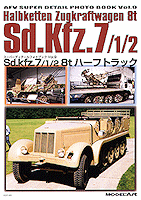 |
Flak Auf Sd.Kfz.7 Part 1 Kagero Photosniper No.9 ISBN: 83-914824-3-X  |
Flak Selbstfahrlafetten and Flakpanzer Panzer Tracts No.12 Doyle/Jentz  |
| Flak
at War Trojca Publications Waldemar Trojca, Karlheinz Münch ISBN: 83-60041-15-6 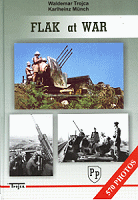 |
Allied & Axis
No.21 Ampersand Publishing Sd.Kfz.7, 8-ton KM m 11 halftrack  |
German Anti-Aircraft Combat Vehicles Revised Edition Ground Power Special Feb '08  |
 for
the review kit.
for
the review kit. 


